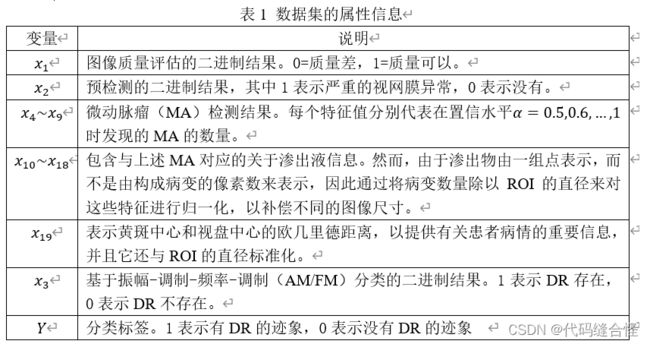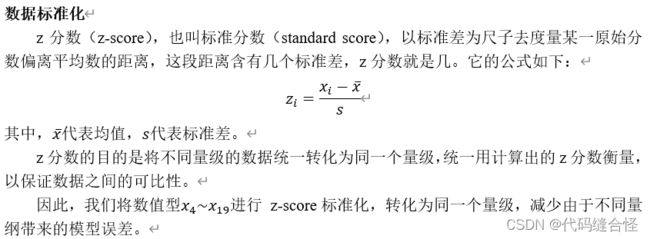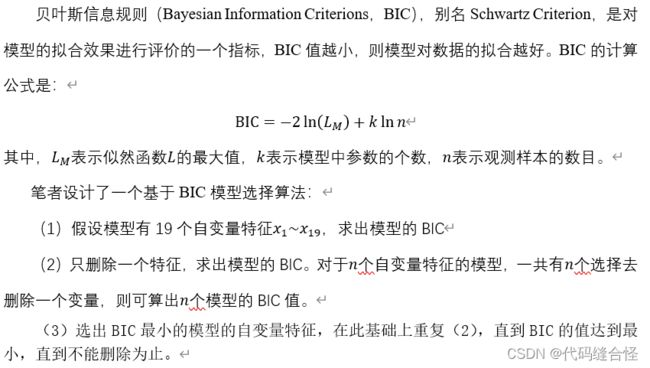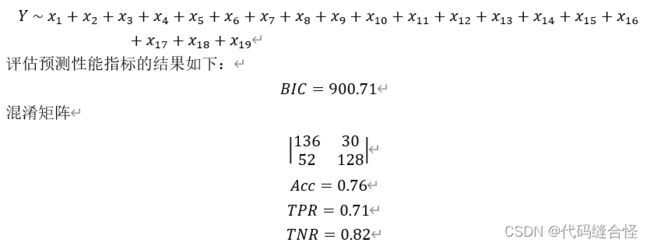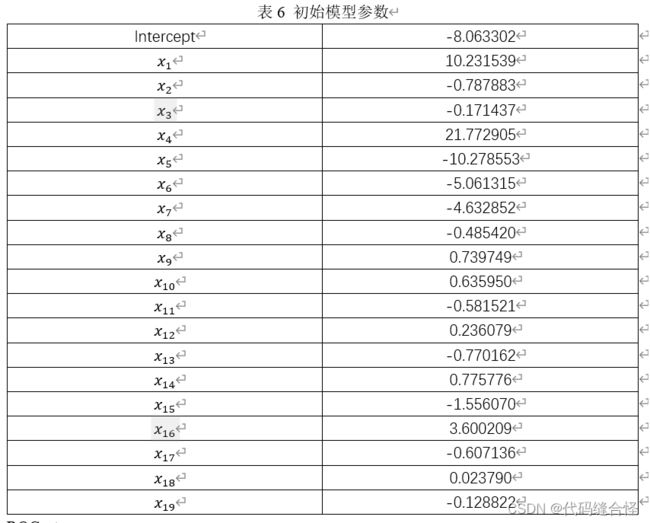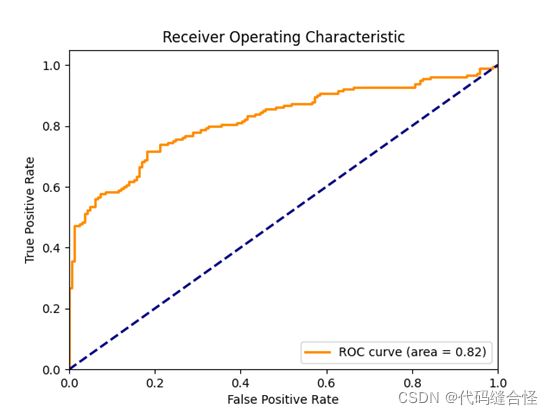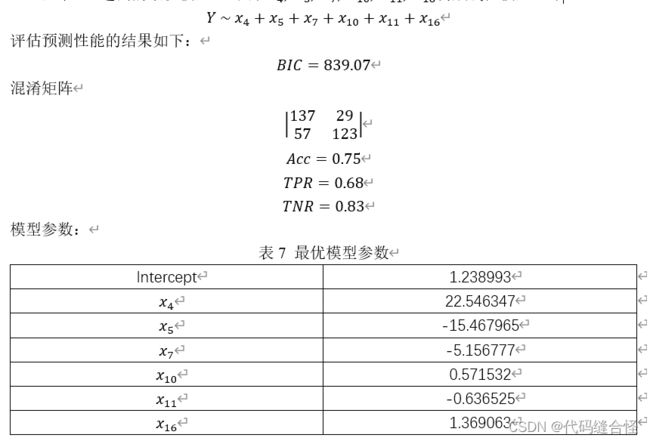基于逻辑回归(Logistic Regression)的糖尿病视网膜病变(Diabetic Retinopathy)检测
基于逻辑回归的糖尿病视网膜病变检测
- 说明
-
- 数据集
- 探索性数据分析
- 方法
- 结果
- 代码
说明
这是我学机器学习的一个项目, 基于逻辑回归(Logistic Regression)的糖尿病视网膜病变(Diabetic Retinopathy)检测 ,该模型采用机器学习中逻辑回归的方式,训练Diabetic Retinopathy Debrecen Data Set的数据集,获得模型参数,建立预测模型,可以有效针对DR疾病做出预测和分类。仅供参考,莫要抄袭!!!
数据集
该数据集是从UCI机器学习库下载的,并且该数据集包含了从Messidor图像集中提取的19个特征,可用于预测图像是否有糖尿病视网膜病变(DR)的迹象,详细信息如表1所示。数据集下载链接:
https://archive.ics.uci.edu/ml/datasets/Diabetic+Retinopathy+Debrecen+Data+Set
探索性数据分析
首先,分析第1类特征(变量x1, x2, x3)。分别绘制变量x1, x2, x3和Y的交叉报表,如表2、表3和表4所示。从表2和表3可以计算出,x1=1的占比为1147/1151≈99.7%,x2=1的占比为1057/1151≈91.8% 。对于变量x3,x3=1表示DR存在,x3=0表示DR不存在,和实际值Y对比,计算出准确率为(347+194)/1151≈47.0%.
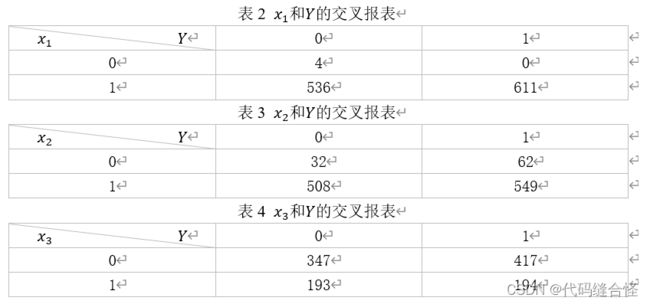
因此,在Messidor图像集中,99.7%的图片的质量可以,能够用来训练逻辑回归模型,91.8%的图片预检测有严重的视网膜异常,而AM/FM的预测结果准确率只有47.0%,准确率偏低,所以变量x1, x2, x3并没有提供有用的信息。

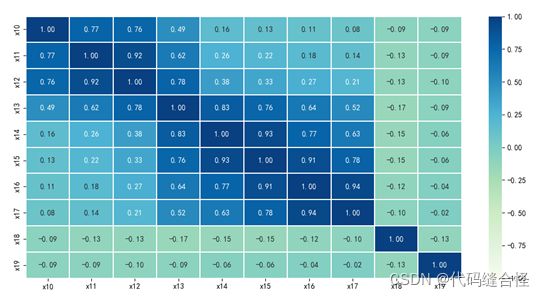

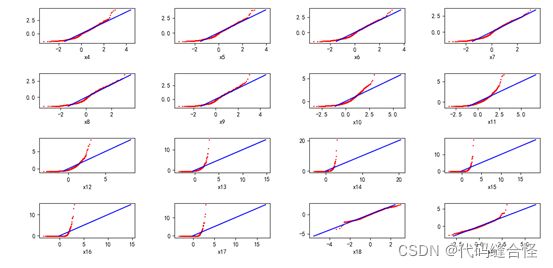
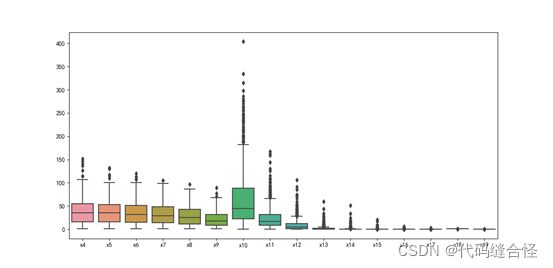
方法
结果
代码
数据分析
import pandas as pd
import seaborn as sns
import numpy as np
import matplotlib.pyplot as plt
from scipy.io import arff
from scipy.stats import norm
# pycharm控制台输出显示pandas设置
pd.set_option('display.max_columns', 1000)
pd.set_option('display.width', 1000)
pd.set_option('display.max_colwidth', 1000)
# plt显示中文
plt.rcParams['font.sans-serif'] = ['SimHei'] # 配置字体,显示中文
plt.rcParams['axes.unicode_minus'] = False # 配置坐标轴刻度值模式,显示负号
# 导入数据
df = arff.loadarff("../homework_2/messidor_features.arff")
print(df)
data = pd.DataFrame(df[0])
Cnames = ['x1', 'x2', 'x4', 'x5', 'x6', 'x7', 'x8', 'x9', 'x10', 'x11', 'x12', 'x13',
'x14', 'x15', 'x16', 'x17', 'x18', 'x19', 'x3', 'y']
# x1, x2, and x3 are binary
data.columns = Cnames
print("data:\n", data.head())
print("shape:", data.shape)
print("统计:\n", data.describe())
data.replace('N/A', np.NAN, inplace=True)
print(data.isnull().any()) # 判断数据集每一列是否有缺失值
print(data.isnull().sum(axis=0)) # 求出每一列对应的缺失值的个数
print("每一列数值统计: \n")
for col in Cnames:
print(data[col].value_counts(), end="\n\n")
# a. 2进制变量的条形图:x1,x2,x3,y
sets = ['x1', 'x2', 'x3']
for col in sets:
temp = pd.crosstab(data.loc[:, col], data.y)
print(temp, "\n\n")
ax = temp.plot(kind='bar', grid=True, title=col+'-y')
ax.set_xlabel(col)
ax.set_ylabel(col+" count")
plt.show()
# b. 相关系数的热力图
# cor = data[['x4', 'x5', 'x6', 'x7', 'x8', 'x9', 'x10', 'x11', 'x12', 'x13',
# 'x14', 'x15', 'x16', 'x17', 'x18', 'x19']].corr()
cor = data[['x10', 'x11', 'x12', 'x13', 'x14', 'x15', 'x16', 'x17', 'x18', 'x19']].corr()
print("相关系数矩阵:\n", cor)
sns.heatmap(cor, cmap='GnBu', annot=True, fmt='.2f',
linewidths=0.1, vmin=-1, vmax=1)
plt.show()
# c. x4-x19的箱形图
sets = ['x4', 'x5', 'x6', 'x7', 'x8', 'x9', 'x10', 'x11',
'x12', 'x13', 'x14', 'x15', 'x16', 'x17', 'x18', 'x19']
sns.boxplot(data=data[sets])
plt.show()
sns.boxenplot(data=data[sets]) # 增强型
plt.show()
sns.stripplot(data=data[sets], jitter=True) # 散点图, 散点左右"抖动"效果
plt.show()
# d. x4-x19的直方图
i = 1
for col in sets:
data1 = data.loc[:, col]
plt.subplot(4, 4, i)
sns.distplot(data1)
i += 1
plt.tight_layout() # 自动调整子图参数,使得子图不重叠
plt.show()
# e.Q-Q plot
i = 1
for col in sets:
data1 = data.loc[:, col]
prob = (np.arange(data1.shape[0]) - 1 / 2) / data1.shape[0]
q = norm.ppf(prob, 0, 1)
y = data1.to_numpy()
y = (y - np.mean(y)) / np.std(y)
y.sort()
plt.subplot(4, 4, i)
plt.scatter(x=q, y=y, color='red', s=1)
plt.plot(y, y, color='blue') # Add a 45-degree reference line
plt.xlabel(col)
i += 1
plt.tight_layout() # 自动调整子图参数,使得子图不重叠
plt.show()
数据训练
import pandas as pd
import numpy as np
import matplotlib.pyplot as plt
from scipy.io import arff
from sklearn import preprocessing
from sklearn.model_selection import train_test_split
import statsmodels.api as sm
from sklearn.metrics import confusion_matrix, roc_curve, auc
# pycharm控制台输出显示pandas设置
pd.set_option('display.max_columns', 1000)
pd.set_option('display.width', 1000)
pd.set_option('display.max_colwidth', 1000)
# 导入数据集
df = arff.loadarff("../homework_2/messidor_features.arff")
data = pd.DataFrame(df[0])
Cnames = ['x1', 'x2', 'x4', 'x5', 'x6', 'x7', 'x8', 'x9', 'x10', 'x11', 'x12', 'x13',
'x14', 'x15', 'x16', 'x17', 'x18', 'x19', 'x3', 'y']
data.columns = Cnames # x1, x2, and x3 are binary
print("data:\n", data.head())
print("shape:", data.shape)
# 数据预处理
x = data.iloc[:, 2:data.shape[1] - 2].astype('float32')
print('before z-score:\n', x)
# z-score 标准化 x
std_scaler = preprocessing.StandardScaler()
x = std_scaler.fit_transform(x)
x = pd.DataFrame(x, columns=Cnames[2:data.shape[1] - 2])
print('after z-score:\n', x)
# 合并
Data = pd.concat([data['x1'].astype('int'), data['x2'].astype('float32'), x, data['x3'].astype('float32'), data['y'].astype('float32')], axis=1)
print('before split:\n', Data)
# 划分测试集和训练集
train_data, test_data = train_test_split(Data, train_size=0.7, random_state=120)
print('after split:\n', train_data)
# 寻找最优训练方法
method_group = []
formula = "y ~ x1+x2+x3+x4+x5+x6+x7+x8+x9+x10+x11+x12+x13+x14+x15+x16+x17+x18+x19"
methods = ['newton', 'bfgs', 'lbfgs', 'powell', 'cg', 'ncg', 'basinhopping', 'minimize']
for method in methods:
model = sm.Logit.from_formula(formula, data=train_data)
re1 = model.fit(method=method)
method_group.append((method, np.round(re1.bic, 2)))
method_group.sort(key=lambda x:x[1], reverse=False) # 从小到大排序
print(method_group)
# 训练
formula = "y ~ x1+x2+x3+x4+x5+x6+x7+x8+x9+x10+x11+x12+x13+x14+x15+x16+x17+x18+x19"
model = sm.Logit.from_formula(formula, data=train_data)
re1 = model.fit(method='ncg')
print(re1.summary())
print("AIC = ", np.round(re1.aic, 2))
print("BIC = ", np.round(re1.bic, 2))
# 可以返回变量的边际效应和对应的置信区间
print(re1.get_margeff(at="overall").summary())
# 评估
# 1.混淆矩阵
y_test = test_data.y
y_pred = re1.predict(test_data)
cut_off = 0.5
y_pred[y_pred >= cut_off] = 1
y_pred[y_pred < cut_off] = 0
print("confusion_matrix:\n", confusion_matrix(y_test, y_pred))
# 2.ROC曲线
tn, fp, fn, tp = confusion_matrix(y_test, y_pred).ravel()
predicted_values = re1.predict(test_data)
fpr, tpr, thresholds = roc_curve(y_test, predicted_values)
roc_auc = auc(fpr, tpr)
lw = 2
plt.plot(fpr, tpr, color='darkorange', lw=lw,
label='ROC curve (area = %0.2f)' % roc_auc) # 假正率为横坐标,真正率为纵坐标做曲线
plt.plot([0, 1], [0, 1], color='navy', lw=lw, linestyle='--')
plt.xlim([0.0, 1.0])
plt.ylim([0.0, 1.05])
plt.xlabel('False Positive Rate')
plt.ylabel('True Positive Rate')
plt.title('Receiver Operating Characteristic')
plt.legend(loc="lower right")
plt.show()
# 3.准确率、TPR、TNR
accuracy = (tn+tp)/(tn+fp+fn+tp)
print("Accuracy = ", np.round(accuracy, 2))
TPR = tp/(tp+fn)
TNR = tn/(tn+fp)
print("TPR = ", np.round(TPR, 2))
print("TNR = ", np.round(TNR, 2))
# 输出模型参数
coef = re1.params # 逻辑回归模型参数 pd.Series
print(coef)
coef_list = []
for i in np.arange(len(coef)):
coef_list.append((coef.index[i], np.round(coef[i], 3)))
coef_list.sort(key=lambda x:x[1], reverse=True) # 将参数从大到小排序
print(coef_list)
# 模型选择
def model_selection(data): # data: DataFrame
col_names = list(data.columns)[:-1]
BIC = []
AIC = []
formula = 'y ~ ' + ' + '.join(list(data.columns)[:-1])
model = sm.Logit.from_formula(formula, data=data)
re1 = model.fit(method='ncg')
AIC.append(('Full Model', np.round(re1.aic, 2)))
BIC.append(('Full Model', np.round(re1.bic, 2)))
for i in range(len(col_names)):
c = list(data.columns)[:-1]
c.pop(i)
formula = 'y ~ ' + ' + '.join(c)
model = sm.Logit.from_formula(formula, data=data)
re1 = model.fit(method='ncg')
AIC.append((col_names[i], np.round(re1.aic, 2)))
BIC.append((col_names[i], np.round(re1.bic, 2)))
AIC.sort(key=lambda x:x[1]) # 将AIC从小到大排序
BIC.sort(key=lambda x:x[1]) # 将BIC从小到大排序
return AIC, BIC
# 基于BIC选择模型:每次找到一个变量,使得删除变量后,AIC和BIC的值达到最小,直到不能剔除为止
flag = 0
feature_drop = [] # 删除的特征
while flag == 0:
AIC, BIC = model_selection(train_data)
if BIC[0][0] == 'Full Model':
break
else:
feature_drop.append(BIC[0][0])
train_data.drop(BIC[0][0], axis=1, inplace=True)
test_data.drop(BIC[0][0], axis=1, inplace=True)
print(feature_drop) # 删除的特征
print(Cnames[0:-1]) # 所有的特征
# 最终模型
fal_formula = 'y ~ '
for ch in Cnames[0:-1]:
if ch not in feature_drop:
fal_formula = fal_formula + ch + '+'
fal_formula = fal_formula[0:-1]
print(fal_formula) # 最终模型表达式
# 最终模型的训练
model = sm.Logit.from_formula(fal_formula, data=train_data)
re1 = model.fit(method='ncg')
print(re1.summary())
print("AIC = ", np.round(re1.aic, 2))
print("BIC = ", np.round(re1.bic, 2))
print(re1.get_margeff(at="overall").summary())
# 评估
# 1.混淆矩阵
y_test = test_data.y
y_pred = re1.predict(test_data)
cut_off = 0.5
y_pred[y_pred >= cut_off] = 1
y_pred[y_pred < cut_off] = 0
print("confusion_matrix:\n", confusion_matrix(y_test, y_pred))
# 2.ROC曲线
tn, fp, fn, tp = confusion_matrix(y_test, y_pred).ravel()
predicted_values = re1.predict(test_data)
fpr, tpr, thresholds = roc_curve(y_test, predicted_values)
roc_auc = auc(fpr, tpr)
lw = 2
plt.plot(fpr, tpr, color='darkorange', lw=lw,
label='ROC curve (area = %0.2f)' % roc_auc) # 假正率为横坐标,真正率为纵坐标做曲线
plt.plot([0, 1], [0, 1], color='navy', lw=lw, linestyle='--')
plt.xlim([0.0, 1.0])
plt.ylim([0.0, 1.05])
plt.xlabel('False Positive Rate')
plt.ylabel('True Positive Rate')
plt.title('Receiver Operating Characteristic')
plt.legend(loc="lower right")
plt.show()
# 3.准确率、TPR、TNR
accuracy = (tn+tp)/(tn+fp+fn+tp)
print("Accuracy = ", np.round(accuracy, 2))
TPR = tp/(tp+fn)
TNR = tn/(tn+fp)
print("TPR = ", np.round(TPR, 2))
print("TNR = ", np.round(TNR, 2))
# 输出模型参数
coef = re1.params # 逻辑回归模型参数 pd.Series
print(coef)
coef_list = []
for i in np.arange(len(coef)):
coef_list.append((coef.index[i], np.round(coef[i], 3)))
coef_list.sort(key=lambda x:x[1], reverse=True) # 将参数从大到小排序
print(coef_list)
